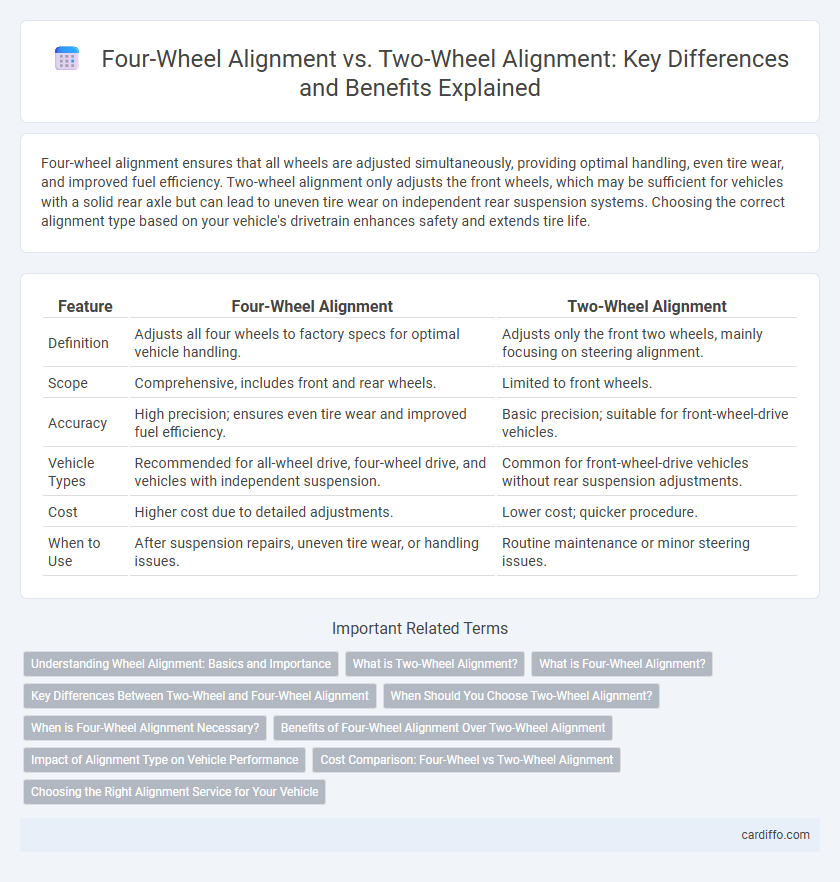Four-wheel alignment ensures that all wheels are adjusted simultaneously, providing optimal handling, even tire wear, and improved fuel efficiency. Two-wheel alignment only adjusts the front wheels, which may be sufficient for vehicles with a solid rear axle but can lead to uneven tire wear on independent rear suspension systems. Choosing the correct alignment type based on your vehicle's drivetrain enhances safety and extends tire life.
Table of Comparison
| Feature | Four-Wheel Alignment | Two-Wheel Alignment |
|---|---|---|
| Definition | Adjusts all four wheels to factory specs for optimal vehicle handling. | Adjusts only the front two wheels, mainly focusing on steering alignment. |
| Scope | Comprehensive, includes front and rear wheels. | Limited to front wheels. |
| Accuracy | High precision; ensures even tire wear and improved fuel efficiency. | Basic precision; suitable for front-wheel-drive vehicles. |
| Vehicle Types | Recommended for all-wheel drive, four-wheel drive, and vehicles with independent suspension. | Common for front-wheel-drive vehicles without rear suspension adjustments. |
| Cost | Higher cost due to detailed adjustments. | Lower cost; quicker procedure. |
| When to Use | After suspension repairs, uneven tire wear, or handling issues. | Routine maintenance or minor steering issues. |
Understanding Wheel Alignment: Basics and Importance
Four-wheel alignment adjusts all wheels to align with the manufacturer's specifications, ensuring optimal handling, tire wear, and vehicle safety, especially for vehicles with independent suspension systems. Two-wheel alignment, commonly used on rear-wheel-drive vehicles, focuses on the front wheels, correcting camber, caster, and toe to improve steering response and tire longevity. Proper wheel alignment directly impacts fuel efficiency, tire lifespan, and overall driving stability, making regular alignment checks essential for maintaining vehicle performance.
What is Two-Wheel Alignment?
Two-wheel alignment, also known as front-end alignment, adjusts the angles of only the front wheels to improve steering and reduce tire wear. This process primarily focuses on correcting camber, caster, and toe settings on the front axle, which affects vehicle handling and tire longevity. Two-wheel alignment is typically used for vehicles with a solid rear axle or those without independent rear suspension.
What is Four-Wheel Alignment?
Four-wheel alignment involves adjusting the angles of all four wheels to ensure they are set to the vehicle manufacturer's specifications, improving handling, tire wear, and fuel efficiency. Unlike two-wheel alignment, which only adjusts the front wheels, four-wheel alignment addresses both the front and rear wheels, making it essential for vehicles with independent rear suspension or all-wheel drive systems. Precision in four-wheel alignment enhances overall vehicle stability, steering response, and prolongs tire lifespan.
Key Differences Between Two-Wheel and Four-Wheel Alignment
Two-wheel alignment adjusts only the front wheels, focusing on toe and caster angles, while four-wheel alignment corrects all four wheels, including camber, caster, and toe. Four-wheel alignment is essential for vehicles with all-wheel drive or independent rear suspension to ensure balanced handling and even tire wear. Two-wheel alignment is typically sufficient for front-wheel drive vehicles with solid rear axles, making it a more cost-effective option for basic alignment needs.
When Should You Choose Two-Wheel Alignment?
Two-wheel alignment is ideal for vehicles with a front-wheel-drive system or when only front tires show uneven wear, optimizing steering precision and tire longevity. It is most effective during routine maintenance or after minor impacts that affect only the front axle. Choosing two-wheel alignment helps maintain proper camber and caster settings on the front wheels without unnecessary adjustments to the rear, offering a cost-effective solution for specific alignment issues.
When is Four-Wheel Alignment Necessary?
Four-wheel alignment is necessary when all four wheels need adjustment due to uneven tire wear, suspension repairs, or after a significant impact such as hitting a curb or pothole. Unlike two-wheel alignment, which only adjusts the front wheels, four-wheel alignment ensures that both front and rear wheels are correctly aligned for optimal handling, safety, and tire longevity. Vehicles with independent rear suspension or all-wheel drive systems particularly benefit from four-wheel alignment to maintain proper traction and stability.
Benefits of Four-Wheel Alignment Over Two-Wheel Alignment
Four-wheel alignment ensures all tires are properly adjusted, improving overall vehicle stability, tire life, and fuel efficiency compared to two-wheel alignment that only focuses on front wheels. It corrects camber, caster, and toe angles for both front and rear wheels, preventing uneven tire wear and enhancing road handling. Advanced four-wheel alignment technology provides precise adjustment data, tailored to specific vehicle models for optimal performance and safety.
Impact of Alignment Type on Vehicle Performance
Four-wheel alignment ensures precise adjustment of all wheels, improving overall vehicle stability, tire wear, and fuel efficiency compared to two-wheel alignment, which only adjusts the front wheels. This comprehensive alignment minimizes uneven tire wear and enhances steering response, especially in modern vehicles with independent rear suspensions. Proper four-wheel alignment also prevents strain on suspension components, leading to better handling and extended vehicle lifespan.
Cost Comparison: Four-Wheel vs Two-Wheel Alignment
Four-wheel alignment generally costs between $100 and $200, reflecting its comprehensive adjustment of all wheels for optimal vehicle handling. Two-wheel alignment is typically cheaper, ranging from $50 to $100, as it only involves the front wheels, making it suitable for vehicles with a solid rear axle. Choosing the appropriate alignment depends on the vehicle type and suspension system, impacting overall maintenance expenses and tire longevity.
Choosing the Right Alignment Service for Your Vehicle
Four-wheel alignment ensures all wheels are perfectly aligned with each other and the vehicle's frame, providing better handling, tire wear, and fuel efficiency, especially for vehicles with independent suspension or all-wheel drive. Two-wheel alignment typically focuses on the front wheels and suits vehicles with a solid rear axle or those that primarily steer with the front wheels. Choosing the right alignment depends on your vehicle's suspension type, drivetrain, and manufacturer recommendations, balancing maintenance costs with optimal performance.
Four-wheel alignment vs two-wheel alignment Infographic

 cardiffo.com
cardiffo.com